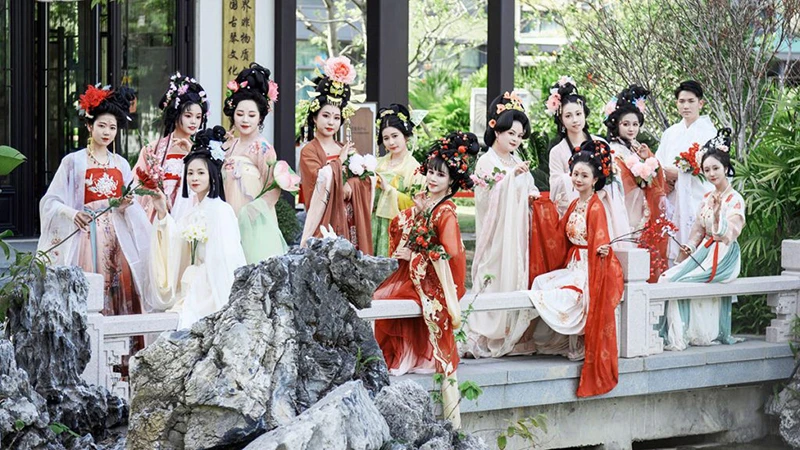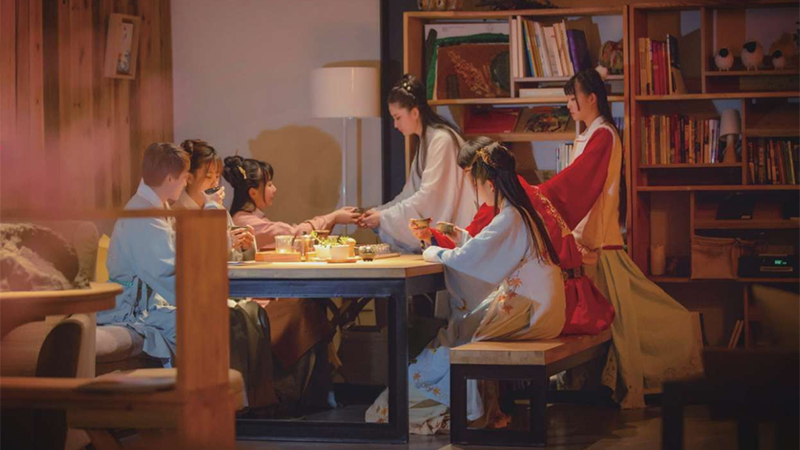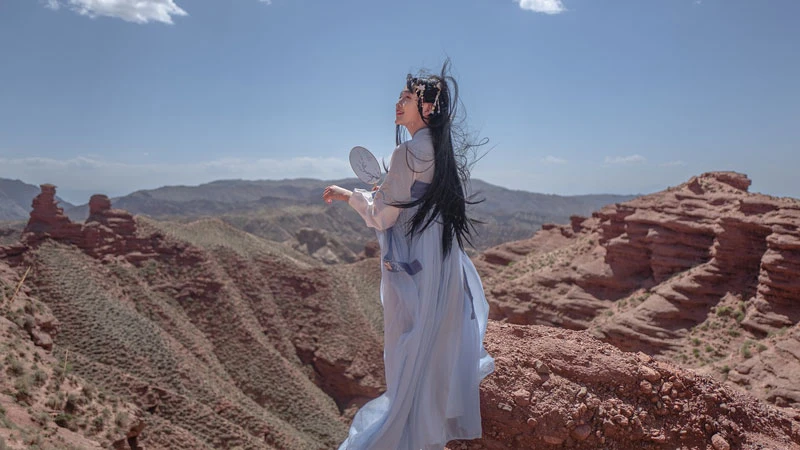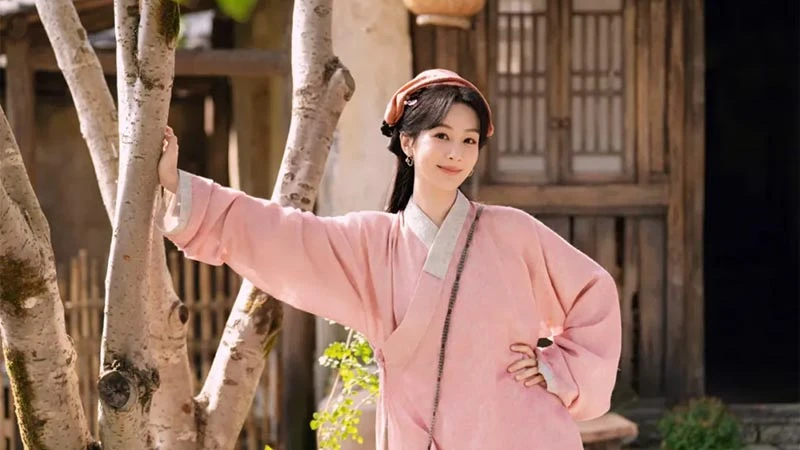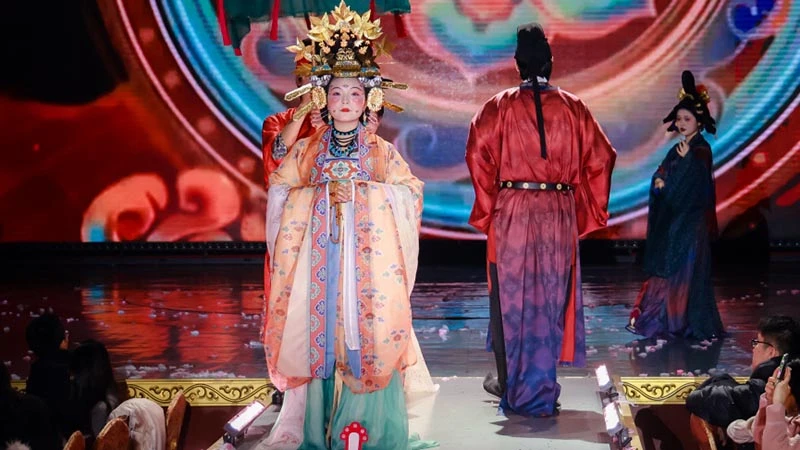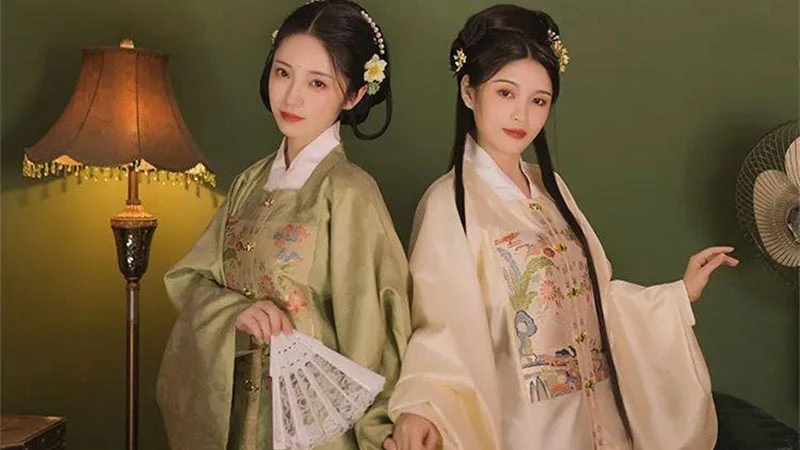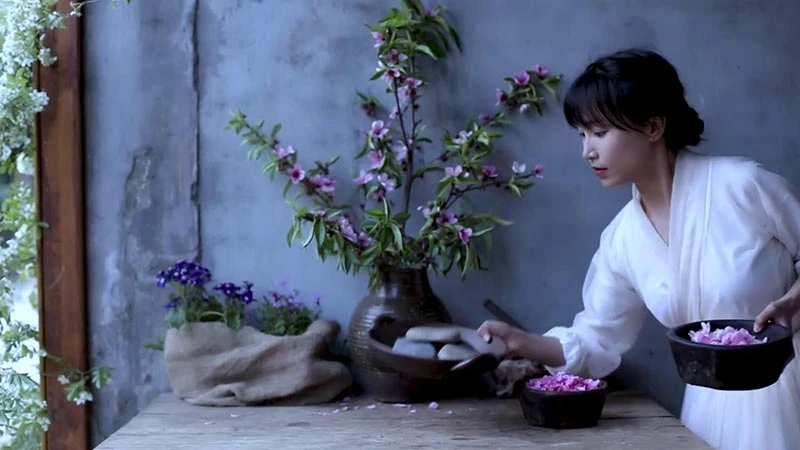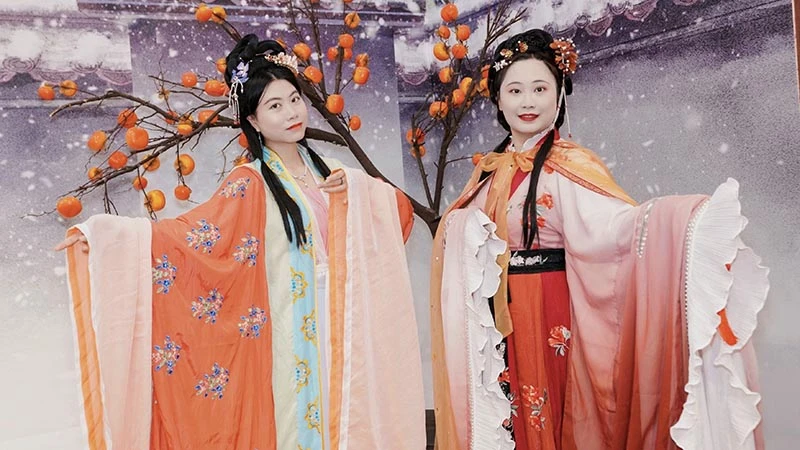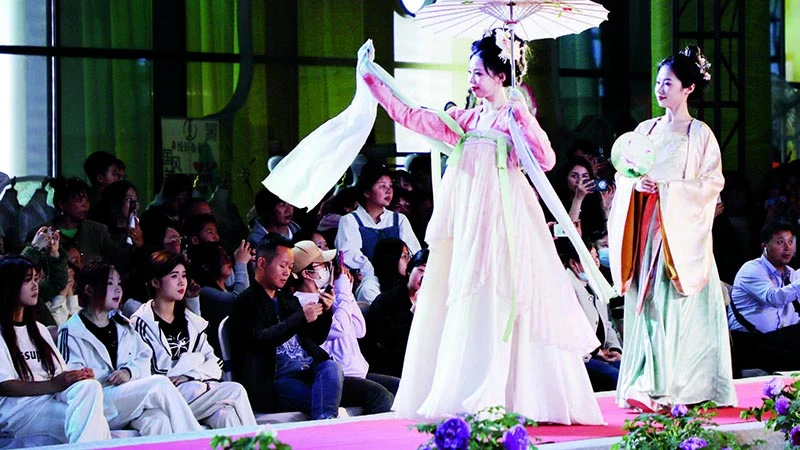Article
搜索结果:
-
The Trendy Hanfu Styles: Fragmentation & Fatalism
In the past year, various concepts of 'fragmentation' and 'fatalism' have suddenly become popular online. Paired with trendy Hanfu styles such as the straight-fronted robe of the 'Warring States' period, the silk shirt of the Northern Song Dynasty, Tang-style shirts and skirts, and armor, there are all sorts of scenarios: running away in the rainy back - view, collapsing in the ice and snow, being tied up, drawing a sword, dying in battle, and even imitating Emperor Chongzhen's 'hanging himself'. It's really a wide variety, giving us a fresh feeling of fatalism. Understanding 'Fragmentation' and 'Fatalism' What exactly are 'fragmentation' and 'fatalism'? Do we really need this kind of emotional appeal? In short, this kind of aesthetic doesn't necessarily have to be called 'fragmentation' or 'fatalism'. It's a kind of incomplete, heart - wrenching but irresistible sadness. Originally more common in the fields of painting and sculpture, with the lower threshold of shooting short dramas and taking photos and the improvement of costumes and props, ordinary people have more opportunities to touch those emotional corners that are usually hard to notice and seek deep 'resonance'. Creating the Atmosphere To create this sense of fatalism, besides creating extreme environments, for example,… -
Noble Lady - Chen Duling's Ming Dynasty Hanfu
Recently, the filming of "Noble Lady" starring Chen Duling (陈都灵) wrapped up, and some promotional and on - set photos of Chen Duling were released online. Some netizens said that the costumes looked a bit cheap and made the characters look old. However, another group of netizens thought that they finally saw authentic Ming - style Hanfu in a costume drama. The costumes in "Noble Lady" mainly follow the traditional Ming - Dynasty style of Hanfu. They are mainly high - collared, cross - collared long jackets, with cloaks worn over them on formal occasions, and horse - face skirts as the lower skirts. The Ming - style costumes in this drama also include high - collared, vertical - collared and cross - collared jacket - skirt sets, as well as traditional cross - collared jacket - skirt sets. Through different color combinations and patterns, the lively and playful sides of the characters can be highlighted. The overall style of the costumes in this drama is quite grand, covering printing, gold - weaving, embroidery, and hidden - pattern techniques. As the characters' identities change in the plot, the costumes gradually show the elegance of Ming - Dynasty noble ladies. Among… -
Explore the Ancient Hanfu Pibo: the Draped Shawl
At a recent event, actress Zhou Ye (周也) stunned in a shawl draped in a way reminiscent of her character in Scent of Time (为有暗香来). This sparked a wave of admiration online: “Who knew a shawl could be worn like this? Fashion truly transcends time!” Indeed, the various ways modern shawls are styled bear a striking resemblance to the classical pibo (披帛) of ancient China. While today’s shawls come in a variety of materials and styles, their role in enhancing an outfit remains unchanged. And just like in ancient times, there’s more than one way to wear them. The Evolution of Draped Elegance The concept of draping fabric over the shoulders dates back thousands of years. As early as the Wei and Jin dynasties, terracotta figurines depicted women wearing short, wide scarves known as 帔 (pei) or 披 (pi). These early forms of pibo were not just functional but also stylish, much like modern scarves. A poetic reference from the Southern and Northern Dynasties describes a woman’s elegance: "Her step-shaking hairpin sways, and the red edges of her pei flutter." By the Tang Dynasty, the pibo had evolved into a long, narrow accessory, becoming an essential part of women’s fashion.… -
How Hanfu is Shaping Modern Trends in 2024
Hanfu, the traditional clothing of the Han Chinese, has experienced a remarkable resurgence. What was once a niche interest among history enthusiasts and cultural purists has now blossomed into a full-blown fashion movement. By 2024, the Hanfu market is not just thriving—it’s evolving, adapting, and influencing modern fashion in ways that few could have predicted a decade ago. The Hanfu Phenomenon The Hanfu revival isn’t just about clothing; it’s a cultural statement. Rooted in over 3,000 years of history, Hanfu represents more than just aesthetics—it’s a symbol of identity and heritage. In 2024, this traditional attire has found its way into the wardrobes of a diverse audience, from young students to working professionals, and even international fashion enthusiasts. The driving force behind this resurgence? A combination of government support, cultural pride, and the rise of China-chic (国潮). Policies promoting traditional culture, such as the "14th Five-Year Plan for the Development of Chinese Traditional Culture," have played a significant role in boosting public interest. Events like China Huafu Day (中国华服日) and Huazhao Festival (花朝节) have further cemented Hanfu’s place in contemporary culture, turning it into a symbol of national pride. The Market Boom: Numbers Don’t Lie The numbers speak for themselves.… -
Festivals & Hanfu: A Seasonal Style Guide
Ancient Chinese wisdom distilled clothing choices into simple truths: light robes for summer, padded jackets for winter. But look closer, and you’ll find a nuanced system—24 solar terms (节气), 72 micro-seasons (物候), and festivals each demanding specific colors and motifs. This wasn’t just practicality; it was a silent dialogue between humans and the rhythms of nature.. Chapter 1: Lunar New Year (春节) The tradition of wearing new clothes for the Lunar New Year is widespread in Chinese culture. Regardless of social class, people are expected to wear their finest attire to usher in the new year. For officials and those of higher status, formal ceremonial clothing is a must. The colors of these garments—red, blue, yellow, white, and black—offer a range of options, but certain traditions guide their use. White is typically worn for mourning, red symbolizes celebration, and yellow was reserved for emperors after the Tang Dynasty. Red, blue, and black are more common, with red standing out as a symbol of prosperity, joy, and good fortune. Throughout the New Year festivities, red decorations such as firecrackers, lanterns, and spring couplets (春联) fill the environment, creating an atmosphere of happiness and festivity. Red has become the hallmark of wealth… -
Bai Lu vs Li Yitong: Same Little Fox Fairy Hanfu
In many ancient costume or xianxia (仙侠) dramas nowadays, the same costume stylist is often used, so it's easy to have some "dressing alike" situations. Bai Lu and Li Yitong not only wore the same clothes but also had the same hairstyle. They both had the little fox makeup and styling. Moreover, there is only a four - year age gap between Li Yitong and Bai Lu. Many people even say they look like twins and sometimes can't tell them apart. But with the same Hanfu and hairstyle this time, unexpectedly, Bai Lu looks more like Li Yitong's elder sister. Analysis of Bai Lu's Hairstyle and Appearance in Xianxia Drama First, let's look at the hairstyle. There are two frizzy ponytails on the head, highlighting the little fox's liveliness and playfulness. Double ponytails also make one look more innocent. Xianxia Hanfu usually has a slightly exaggerated beauty, creating an effect of a mountain elf. Bai Lu is just like this. From afar, she looks exactly like a little fox from the forest taking its first step into the world, lively and a bit cute. Bai Lu's face and figure are quite ordinary. With a face shape more like that of… -
Qingdao's Hanfu Ruohua Floss Flower Auntie
Bringing Ancient Skills Back to Life The inheritor of 'Yu's Floss Flowers', Yu Hui, uses her dexterous hands and passion to revive this millennium - old skill. In the courtyard of Building 25, Xingguo Road, Yongping Road Community, Xinghua Road Sub - district, Licang District, everyone knows Yu Hui. In her home, there are many exquisite floss flower works, each lifelike and full of unique charm. Yu Hui has breathed new life into the ancient art of floss flower making. Family Heritage Yu Hui, 46 years old this year, was introduced to floss flowers in her childhood. Her ancestors were court floss flower craftsmen in the late Qing Dynasty, and the family skill has been passed down for generations. The sight of her grandmother making ornaments made her fall in love with floss flowers. When she grew up, she actively asked the elders to teach her. Although it was tough, she mastered the essence and realized that only by infusing her heart could the floss flowers come alive. During the inheritance process, she found that some traditional techniques were missing and had to figure them out through practice. Adhering to the Craftsmanship With the passage of time, the floss flower… -
At 34, Li Yitong Wears a Guanyin Veil and Dunhuang Hanfu
At 34, Li Yitong (李一桐) wears a Guanyin veil and Dunhuang-style Hanfu, looking like a dancing elf in the wind. With such good looks, she is truly cut out for ancient idol dramas! Li Yitong became well - known for her role in My Half - Fairy Princess. Her beauty combines sweetness with a touch of innocent allure, different from the typical delicate - flower appearance. Many people say she has an under - the - radar star quality, as none of her works have achieved huge popularity. However, everyone knows her, and she has a good rapport with the audience. Although she is in her 30s, her face still looks young, like a little girl, which doesn't seem out of place in her roles. Her recent ancient costumes have really taken people by surprise. Compared with her peers, Li Yitong takes good care of her face. Her eyes are full of sparkle, so she has no problem playing young girls. However, she was criticized for her performance in The Knockout, indicating that she may not be suitable for mature and intellectual roles. The Guanyin veil is a commonly seen headpiece in recent ancient dramas. Usually, we see short or… -
Gulnazar in Wei and Jin Dynasty Hanfu
Gulnazar looks like a dragon princess in the Hanfu of the Wei and Jin Dynasties. She is like a flower without fragrance but is beautiful enough. In terms of beauty, Gulnazar definitely belongs to the high - value group in the entertainment circle. It's said that Xinjiang people tend to look old as they age, but this doesn't seem to apply to Gulnazar. Her skin remains delicate and resistant to aging. This set of Hanfu has amazed many people. It gives a strong sense of a dragon princess appearing. As a Xinjiang native, Gulnazar has a natural exotic charm, with bold and delicate facial features. She is a typical gorgeous beauty. The blue long - sleeved Ru Hanfu of the Wei and Jin Dynasties exudes an air of elegance and luxury everywhere. The Hanfu is also exquisitely made. Beautiful clothes should be worn by beautiful women, and the Hanfu will then be endowed with a soul. The spacious long sleeves give a sense of security and add a touch of playfulness. There is a thin shirt and embroidery on the outside. It not only has a good texture but also looks very noble. At the same time, it adds a… -
58-Year-Old Carmen Lee Stuns in Hanfu
Carmen Lee (李若彤), the actress best known for her iconic role as the "Dragon Girl" in Return Of The Condor Heroes (神雕侠侣), has once again captured the public’s attention—this time, not for her acting, but for her breathtaking appearance in Hanfu, traditional Chinese clothing. At 58, Lee’s grace and poise have left fans in awe, proving that true beauty transcends age. Whether in modern attire or ancient garments, she exudes a blend of elegance and strength that continues to inspire. A Perfect Match for Song Dynasty Style Lee’s recent Hanfu looks draw inspiration from the Song Dynasty, a period renowned for its understated yet sophisticated fashion. Her outfits typically feature a cross-collar blouse paired with pleated skirts, a classic combination that reflects the refined taste of noblewomen from that era. The addition of a pibo (披帛, a long silk scarf) adds a touch of fluidity and grace, enhancing the overall aesthetic. Her makeup, reminiscent of the Tang and Song dynasties’ Feixia style (飞霞妆), involves a light layer of rouge topped with white powder, creating a delicate, rosy glow. This technique, also seen in Liu Yifei’s (刘亦菲) portrayal in A Dream of Splendor (梦华录), complements warm skin tones beautifully, making it… -
Hanfu in Modern Education: Integrating Traditional Attire into School Curriculums
In recent years, the resurgence of Hanfu, the traditional clothing of the Han Chinese people, has gained significant momentum. This revival is not just a fashion statement but a cultural movement aimed at reconnecting with China’s rich heritage. With increasing interest in traditional culture, a growing number of educators and scholars are advocating for the integration of Hanfu into modern school curriculums. But how can historical attire fit into today’s fast-paced, technology-driven education system? Let’s explore the potential benefits, challenges, and practical methods of incorporating Hanfu into modern education. The Historical Significance of Hanfu Before diving into how Hanfu can be introduced into education, it's crucial to understand why it matters. Hanfu, which dates back over 3,000 years, represents the essence of traditional Chinese aesthetics, etiquette, and philosophy. It was the standard attire throughout numerous dynasties until the late Ming and early Qing periods when it was replaced by Manchu-style clothing. Hanfu is not just fabric and embroidery; it is a reflection of Confucian ideals, hierarchical social structures, and historical craftsmanship. By integrating Hanfu into education, schools can offer students a tangible link to their cultural roots. In a globalized world, where Western influences dominate fashion and lifestyle choices, Hanfu… -
Decoding Wang Churan’s Hanfu
During the CCTV Spring Festival special Golden Snake Dance: The Flavor of Chinese New Year (金蛇起舞•中国年味), actress Wang Churan (王楚然) made a stunning appearance in traditional Hanfu attire. However, it wasn’t her flowing robes that caught the audience’s attention—it was her hairstyle. Two neatly trimmed strands of hair framing her face led some viewers to question: Was this a nod to Japanese hime cut (公主切), or a genuine representation of ancient Chinese fashion? The Truth Behind the Hairstyle The hairstyle in question, known as chuishao ji (垂髾髻), dates back to the Han (206 BCE–220 CE) and Jin (266–420 CE) dynasties. Historical artworks like Admonitions of the Instructress to the Court Ladies (女史箴图) and The Wise and Benevolent Women (列女仁智图) depict women with high buns adorned with strands of hair neatly trimmed at the temples. This style, often enhanced with hairpieces, was a hallmark of aristocratic fashion during the Eastern Han Dynasty. The chuishao ji wasn’t just a random choice—it was a deliberate aesthetic statement. The trimmed strands, known as fenshao (分髾), were meant to frame the face elegantly, creating a balance between structure and softness. Archaeological findings, such as jade carvings from the Warring States period (475–221 BCE) and murals… -
Finding Fabrics: "Thrifted" Hanfu Materials
Why should hanfu makers turn to thrift stores? For the deals, of course! -
Yang Zi Stuns in Ming Dynasty-Inspired Hanfu
Chinese actress Yang Zi (杨紫), known for her versatile roles in television dramas, has once again captured the public’s attention—this time, not for her acting, but for her impeccable fashion sense. Recently, the star shared photos of herself dressed in Hanfu, traditional Chinese clothing, to celebrate the Lantern Festival. The images, which quickly went viral, showcased Yang Zi in two stunning Ming Dynasty-inspired outfits, sparking discussions about the modern revival of Hanfu and its place in everyday fashion. A Nod to Ming Dynasty Elegance Yang Zi’s Hanfu choices are rooted in the Ming Dynasty (1368–1644), a period known for its rich cultural heritage and distinctive fashion. The two outfits she wore are variations of aoqun (袄裙), a traditional style consisting of a top (ao) and a skirt (qun). The first ensemble features a soft pink ao with a crossed collar, paired with a gray pleated skirt. The second look is a refreshing green ao with a front-opening design, layered over a subtle red undergarment, creating a harmonious yet striking color contrast. What makes Yang Zi’s outfits stand out is their accessibility. Unlike the elaborate Hanfu often seen in historical dramas, her choices are tailored for modern wear. The muted tones—pink,… -
Neon Robe Competition: Hanfu Design in Universities
In the heart of Xi'an, the “Neon Robe (霓裳萬象)” First National Hanfu Design Competition concluded on January 20, 2025, marking a significant milestone for both fashion and cultural heritage. This inaugural event, a collaboration of over 120 universities and independent designers from around the world, has brought Hanfu—the traditional Chinese attire—into the limelight, encouraging not only a revival of ancient garments but also innovation in their design. The competition, held at Xi’an Engineering University, highlighted the vibrant academic and creative energy that has been brewing in Chinese fashion institutions. A staggering 1,100 entries were submitted, showcasing a global mix of talent from prestigious universities like Tsinghua University, Central Academy of Fine Arts, and Jiangnan University, as well as international participation from the University of Southampton and Ewha Womans University. At the heart of this movement is a strong desire to merge traditional craftsmanship with modern sensibilities. Wang Zizhu (王梓竹) from Tsinghua University earned the top honor with her exquisite design, "Ruo Yi Yì Zi Yan" (罗衣曳紫烟), which combines delicate historical elements with contemporary flair. This piece, which reflects the profound cultural symbols woven into Hanfu, marks a culmination of technical skill and a deep understanding of the garment’s symbolic significance.… -
Xi'an's Hanfu: Youth Embrace Ancient Chinese Cultural Aesthetics
The vibrant city of Xi'an, historically known as the cradle of Chinese civilization, has witnessed a cultural renaissance of sorts. In recent years, the streets and landmarks of this ancient city have become a living museum of traditional Chinese fashion—particularly Hanfu, the traditional clothing that dates back to the Han Dynasty. What was once considered an artifact of history has now made a bold return to the streets, worn by young people in daily life and by tourists looking to engage with Chinese heritage in a deeply immersive way. This resurgence has sparked interest worldwide, making Xi'an one of China's leading cultural hubs. In this article, we delve into the multifaceted role of Hanfu in Xi'an, its relationship to cultural confidence, and the broader implications for China's cultural identity today. Xi'an, known as the ancient capital for over 13 dynasties, is a city where history and modernity collide. For thousands of years, the city has been a center of political, cultural, and economic power in China. The Han and Tang dynasties, in particular, left an indelible mark on the city’s legacy, contributing to an atmosphere filled with ancient cultural relics and awe-inspiring architectural wonders. With the rise of Hanfu,… -
Li Ziqi Wears Hu Bugui’s Viral Hanfu
A Fortuitous Spotlight When Henan TV released its Chinese New Year Gala teaser on January 15th, a particular moment sparked excitement across social media. Internet sensation Li Ziqi (李子柒) appeared in a dazzling red modified Hanfu, holding a lion lantern, exuding an ethereal beauty. Astute fans soon connected her stunning outfit to a popular design sold on an e-commerce platform—a creation by Hu Bugui (胡不归), a rising star in Hanfu design. Hu, both the shop owner and designer, hadn’t anticipated this moment of fame. “It was a complete surprise,” she admitted in an interview. “We never collaborated with Li Ziqi, but seeing her wear my design felt surreal.” Within hours, her store was inundated with inquiries, with buyers scrambling to own what was now dubbed the "Li Ziqi Hanfu." The Story Behind the Design The Hanfu in question, a three-piece modified Ming-style ensemble named Yu Nian (余年), has been one of Hu’s bestsellers. Priced at around 1,400 RMB, it features a red jacket inspired by palace walls, a high-necked blouse, and a horse-face skirt embroidered with golden characters reading “岁岁长安皆有所盼” (Hopes for everlasting peace and prosperity). Hu designed it three years ago with the theme of New Year festivities in… -
The Latest Hanfu Trend in Modern China
The revival of Hanfu, traditional clothing of the Han ethnic group, has become a defining cultural trend in modern China. From parks to shopping malls, young enthusiasts can be seen wearing the elegant, flowing garments, reflecting both aesthetic appreciation and cultural pride. This phenomenon is more than a passing trend; it signifies a deeper connection to history and tradition. Hanfu’s history is a testament to the cultural evolution of the Han people. Broadly speaking, it encompasses various traditional styles developed over millennia, absorbing elements from different ethnic groups. Narrowly defined, it often refers to garments from the Han Dynasty, which established core stylistic elements such as crossed collars, wide sleeves, flat cutting techniques, and the use of silk or hemp materials. While Hanfu adapted and evolved, these fundamental characteristics remained unchanged, highlighting its ability to blend innovation with tradition over 2,000 years. This adaptability is a key reason why Hanfu has endured and now resurges as a symbol of cultural pride. The Challenges Facing the Hanfu Movement Despite its historical roots, the modern Hanfu movement is not without controversy. The rapid growth of the Hanfu market, now valued at over 10 billion RMB, has led to significant challenges. Some designs… -
Breathing New Life into Wei-Jin Hanfu
In a world increasingly captivated by modern fashion, a young designer at Wuhan Textile University is proving that ancient styles can be just as enchanting. Li Yanjun (李艳君), a graduate student with a passion for traditional Chinese culture, has recreated the flowing garments of the Wei-Jin period, inspired by the legendary Luo Shen Fu painting (洛神赋图) by Gu Kaizhi (顾恺之). Her meticulous work, showcased in a serene photoshoot at the Qingchuan Pavilion (晴川阁), has garnered widespread acclaim, with her video on Bilibili amassing over 14,000 views. A Vision of Wei-Jin Hanfu Li's recreation draws directly from the Luo Shen Fu painting, a celebrated Eastern Jin masterpiece illustrating the romantic tale of Cao Zhi and the goddess Luo Shen. The attire, known as the "zaju chuishou" (杂裾垂髾) ensemble, includes a flowing daxiushan (大袖衫, large-sleeved robe), a banbi (半臂, short-sleeved garment), a biji (蔽膝, knee cover), and a ruqun (襦裙, skirt). Li spent 40 hours intricately embroidering a crimson biji with starry cloud patterns, a design chosen to reflect the ethereal nature of the goddess. “The biji is more than just an accessory,” Li explained. “Its triangular drape was key to the elegance and symbolism of Wei-Jin attire, marking status and adding… -
Dong Mingzhu's Hanfu Experience in Cao County
It was an ordinary day in the historic streets of Luoyang when Dong Mingzhu (董明珠), a celebrated Chinese business leader, donned her first Hanfu—a pale blue Ming-style ensemble that caught the eyes of onlookers. Just eight days later, she returned, this time wearing a regal Tang dynasty outfit that matched her commanding presence. Accompanied by her friends, each draped in their chosen styles, Dong’s adventures became a viral moment for Hanfu lovers across China. While Dong’s choice in Hanfu showcased her unique personality, the quiet star of her story was an unassuming county in Shandong—Cao County (曹县). The Hanfu she wore, like many others seen in ancient-style photoshoots or festivals, originated from this lesser-known corner of China. The Small Town with Big Hanfu Dreams Located in southeastern Shandong, Cao County has undergone a cultural and economic metamorphosis. On the surface, it remains humble—far from the bustling touristy image one might expect. But venture fifteen kilometers to Daji Township, and you step into a thriving hub of creativity and entrepreneurship, where small shops handle everything from fabric cutting to digital printing and logistics. Once famous for its mass production of performance costumes, Cao County has emerged as a center of affordable…



